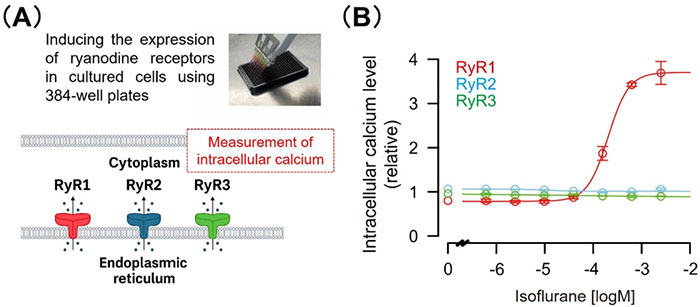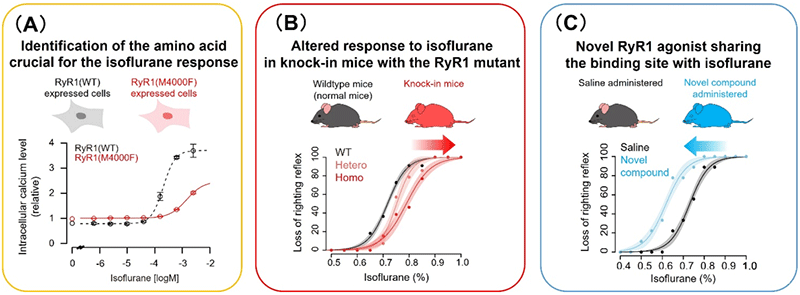Since their anesthetic effects were discovered approximately 180 years ago, inhalational anesthetics have been used for general anesthesia in surgical operations. However, the mechanism of their anesthetic has not been fully revealed yet. Previous studies have shown that inhalational anesthetics exert their anesthetic effects by acting on multiple proteins, but the presence of unknown target molecules has also been suggested.
In rare cases, patients with abnormal type 1 ryanodine receptors (RyR1) (RyR1 mutations) have been known to be at higher risk of malignant hyperthermia*1, which can be caused by inhalational anesthetics. However, the direct molecular interaction between inhalational anesthetics and RyR1 has not been clearly demonstrated, and the relationship between RyR1 and anesthetic effects has also been unknown.
In the present study, a research group led by Professor Hiroki Ueda of the Graduate School of Medicine, The University of Tokyo, found that RyR1 which is a calcium release channel, induces general anesthesia by serving as a target molecule of inhalational anesthetics.
The research group first confirmed that isoflurane and other inhalational anesthetics activate RyR1 and stimulate calcium release from the endoplasmic reticulum*2. The amino acid residues in RyR1 which play an important role in the isoflurane-induced activation were identified, and the binding site of isoflurane was estimated. Additionally, the research group created a genetically modified mouse (knock-in mouse*3) which expressed the RyR1 mutant that does not respond to isoflurane. When the knock-in mice were exposed to isoflurane, they demonstrated a partially reduced sensitivity to anesthesia compared to normal mice.
Furthermore, new compounds that target the putative binding site of isoflurane were identified from in silico compound screening and were found to have sedative-like effects in mice. These results suggest that RyR1 is a functional target of isoflurane that is directly related to its anesthetic properties.
This research reveals one aspect of the molecular mechanism of inhalational anesthetics used for general anesthesia. This is a new finding as previous studies have not demonstrated the relationship between RyR1 and anesthetic effects in mammals. A more detailed understanding of anesthetics' mechanism of action could lead to the development of better anesthetics and treatment methods.
The results of this study were published in the online version of the American scientific journal PLOS Biology on June 3, 2025 (EDT).
This result was achieved in the Ueda Biological Timing Project, a research area of the Exploratory Research for Advanced Technology (ERATO) by the Japan Science and Technology Agency (JST). Under this project, JST pursues "systems biology for understanding humans" using the sleep-wake rhythm as a model system and aims to understand information on "biological time," which transcends from molecules to individual humans living in society.
<Notes>
(*1) Malignant hyperthermia
Life-threatening elevation in body temperature that occurs during general anesthesia. It occurs in patients with genetic predisposition (frequently RyR1 mutation) when they are administered inhalational anesthetics. Dantrolene, an inhibitor of ryanodine receptors, is used as the therapeutic agent.
(*2) Endoplasmic reticulum
A structure inside the cells that is enveloped by biological membrane and is one of the cellular organelles. It also functions as a storage of intracellular calcium. By being stored in the endoplasmic reticulum, intracellular calcium is normally maintained at a low concentration.
(*3) Knock-in mouse
A genetically modified mouse with specific genetic sequences introduced in its genome. This study used a knock-in mouse that was modified in certain genetic regions coding RyR1.
-

Fig1. Experimental schematic of calcium release detection and RyR1 activation by isoflurane (A) Schematic diagram of the experimental system that detects calcium release from the endoplasmic reticulum by each ryanodine receptor.
(B) Isoflurane selectively activates RyR1 (mean ± standard deviation, n = 4).
© Department of Systems Pharmacology, Graduate School of Medicine, UTokyo
-

Fig2. Identification of key amino acid residues and new compounds targeting the putative isoflurane binding site (A) Isoflurane response of RyR1 mutant in which the 4000th amino acid (methionine, M) was replaced with phenylalanine (F). Compared to the wild type (WT, normal RyR1 without mutation), the isoflurane response is reduced (mean ± standard deviation, n = 4).
(B) Loss of righting reflex of knock-in mice expressing RyR1 mutants with reduced isoflurane response (n = 11 to 14). The knock-in mice were partially less susceptible to anesthesia compared to WT mice (normal mice). Hetero: mice in which only one allele is mutated. Homo: mice in which both alleles are mutated.
(C) Loss of righting reflex of mice treated with a novel compound targeting the putative isoflurane binding site (n = 9). The sensitivity to isoflurane was increased. Note that saline has no physiological activity.
The mice illustration was modified from Openclipart (https://openclipart.org/).
© Department of Systems Pharmacology, Graduate School of Medicine, UTokyo
Program Information
- JST ERATO
- Research Project “UEDA Biological Timing”
Journal Information
Hiroyuki J. Kanaya, Ken Kuwajima, Yuko Ito, Yuta Shinohara, Yohei Okubo, Shinnosuke Shiono, Fumiya Tatsuki, Rei-ichiro Ohno, Hideki Ukai, Maki Ukai-Tadenuma, Kenta Sumiyama, Hiroshi Fujishima, Rikuhiro G. Yamada, and Hiroki R. Ueda, “Isoflurane activates the type 1 ryanodine receptor to induce anesthesia in mice”, PLOS Biology. Published online June 03, 2025, doi: 10.1371/journal.pbio.3003172
Contact
-
[About Research]
Hiroki R. Ueda, Professor,
Department of Systems Pharmacology, Graduate School of Medicine, The University of Tokyo
Tel:+81-3-5841-3415
E-mail: uedah-tkyumin.ac.jp
-
[About Program]
Fumie Imabayashi
Department of Research Project, JST
E-mail: eratowwwjst.go.jp
